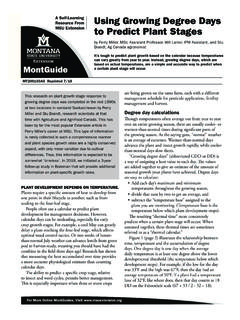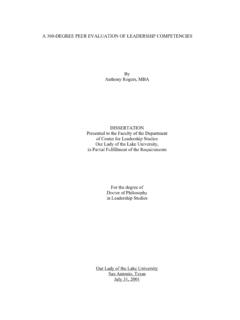Transcription of Dahlia Growing Guide - Dahlia Society of Georgia
1 Dahlia Growing Guide FOR SOUTHERN GARDENS Growing DAHLIAS IS NOT DIFFICULT IF YOU FOLLOW A FEW BASIC Growing PRINCIPLES. THERE ARE TWO BASIC ISSUES THAT GROWERS AND POTENTIAL GROWERS ASK ABOUT MORE THAN ANYTHING ELSE THAT ARE SO IMPORTANT THEY WILL BE ANSWERED AT THIS POINT IN THE Growing Guide . MY TUBER(S) ROTTED AFTER I PLANTED THEM--This is a common problem that too many people experience. Tubers don t have roots when you plant them and it takes about two weeks for them to sprout, so you must have a well-dug-out bed and a light soil for good drainage. The soil temperature needs to be 70 degrees or they will not start Growing . Do not water the planted tubers; let the Spring rains take care of that unless it is a very dry Spring. You may water when the plants are 4-6 tall. You can also start tubers indoors or outdoors after frost, in pots, only lightly watering the tuber and allowing them to get sunlight after a few days in the dark, and only filtered sunlight outdoors.
2 After they are Growing well, they can be transplanted. Sometimes the quality of stock can be an issue and some will just rot. MUST I DIG MY TUBERS IN THE FALL--In a word, NO! In Georgia the ground does not usually freeze so you may leave them there. Make sure you mulch them with pine straw or other material about 4-6 over the tubers. After you cut the stalks off, put a cap of tin foil secured with a rubber band so water won t get into the stalk and rot the crown because that is where the eyes are for next year s growth. They need to be divided every two or three years in order to keep the quality of flowers at their peak and the mass of tubers under the ground manageable. SOIL PREPARATION--DAHLIAS need at least 6 hours of sun a day but up to 10 to 12 hours a day is preferable. Late afternoon shade is OK. Try to get your PH between and is optimal. Dig your bed out between 12 and 18 deep as DAHLIAS must have well-drained soil.
3 Add lots of LEAF MOLD COMPOST, Black Kow or any other type of organic humus as they are heavy feeders. Replace your Georgia clay, if you can, with a better type of soil, or mix with organic amendments. Raised beds need to be 10 or 12 high x 2 boards and a good garden soil mix. PLANTING--Plant your tubers when you plant tomatoes as the soil must be around 70 degrees so they will develop roots. Usually, anytime after May 1st is a good time to plant. Dig the planting hole down to 3 - 6 and lay the tuber in the hole with the Growing tip upward. Planting the tuber too deep can cause it to rot since the soil temperature is not warm enough. Planting it too shallow may cause the sun to burn the Growing tip and allow the tuber to freeze during a difficult winter. When you plant, place a 5 -7 stake next to the eye end for tying the plant as it grows.
4 Cover with soil and do not water unless very dry. Place your tubers anywhere between 18 and 24 apart and rows at least 24 to 36 apart. FERTILIZING--You can use OSMOCOTE 14-14-14, about a tablespoon and a half or small hand-full per plant spread on top of the ground and worked into the soil about 1 . Around August 1st you will need to use something else as the Osmocote runs out. Some growers use MIRACLE GROW ROSE OR TOMATO FOOD. Early September is the point where you want to start cutting back on high rates of nitrogen unless we don't receive adequate rain. Too much nitrogen late in the season can cause the tubers to shrivel in the ground. After Growing dahlias in the same location for a number of years you can have an excess of phosphorous in the ground which can tie up other nutrients. Many experienced growers are only using CALCIUM NITRATE with 19% Calcium which is needed for blooming or UREA (pure nitrogen 46-0-0) (Ebay) three or four times during the year.
5 Neither of these products burn the plants. Ammonium calcium (EBay). Nitrate will burn the plants, so stay away from it. In addition, foliar feeding is also recommended. To improve the strength of the stems, use POTASSIUM NITRATE (Ebay) every couple of weeks during the blooming period. MULCHING--Mulching is very important when Growing DAHLIAS in the South. DAHLIAS came from a climate of warm days and cool nights in the mountains of Mexico and Guatemala and not the hot days and the not-very-cool nights of the South. Dahlia feeder roots run only about 1 under the soil and can extend out from the plant up to 2 in all directions, so they need to stay cool. We must compensate for our heat by Growing heat-tolerant DAHLIAS first and secondly, mulching our plants with at least 2 or more with a good mulch that will let the water through and keep the roots cool so they will grow during the heat of the summer.
6 Make sure you follow this step and put the mulch down by the first of July. WATERING--DAHLIAS like a lot of water but do not like wet feet, so again make sure the soil is well drained. Water about once a week or twice if dry, and make sure it is a deep watering. Do not water the foliage as that will encourage mildew and fungus problems. Over-watering can cause stem or root rot. STOPPING & DISBUDDING--To create a compact bushy plant with more flowers, pinch out the center Growing stalk when the plant is around 1 high and has at least 3-4 sets of leaves. You will only need to do this once. Each lateral will eventually develop three buds. You may (optional) pinch out the two side buds and leave the central bud Growing if you want to increase the size of the one bloom. This is effective on BB (4-6 ), B(6-8 ), A (8-10 ), AA (over 10 ) sized DAHLIAS. INSECT/DISEASE CONTROL--All of the bugs like the tender shoots of DAHLIAS and leaf diseases can be a problem in our hot and humid weather, so your DAHLIAS will do a lot better if you spray weekly.
7 Whatever you use for your other plants will work for DAHLIAS too. When the hot weather comes, sooner or later you will start getting the two-spotted spider mite attacking your plants and will need to use a miticide in order to keep them under control. The best one is AVID, but it is very expensive. An organic alternative called ORGANICIDE THREE IN ONE is less costly but works effectively. It is currently available at Home Depot Stores or you can find it on line. You can purchase AVID in a pint sized container at Powdery mildew is an issue with dahlias and can appear as early as late July. The best new product for Powdery Mildew is called JMS Stylet oil. This product will cure powdery mildew on the infected leaves plus prevent it from happening on un- affected leaves. The organic alternative is NEEM OIL as it will sufficate the spores.
8 Start spraying around the first of August and as needed after that. In the late season the cucumber beetles will eat holes in your blooms and you will have bud worms. MAVRAK is the best product for your blooms and will not discolor them if used at a 50% rate. SEVIN will work also, but may discolor. DEER/CHIPMUNK/VOLE CONTROL Deer will eat your Dahlia plants so you need to use a product to deter them. There are two ways to attack this issue. The first is to use a product called REPELLEX (Google) which is a bit costly. It is a tablet of hot pepper which deer and chipmunks do not like. You must use one per foot of Growth. Two tabs to a plant in the planting hole should be enough as once they get a taste of the pepper they stay away. You must crumble them up with your fingers and then water them in somewhat to activate the pepper. Another method of protecting your tubers from voles and chipmunks is to plant your DAHLIAS in one-gallon pots or wire baskets, and then plant the entire pot below the soil surface.
9 Your DAHLIAS will grow and bloom just like the pot isn t there. IT WORKS! Don t cut the bottom out or drill extra holes in the sides. Another product that is effective against Moles/Voles is called BONDIE MOLE MAX. If you are still having trouble with voles, as they are determined creatures, you will need to trap them. The second method to keep deer and rabbits away from your DAHLIAS is to use a product called LIQUID FENCE. It is organic, made from rotten eggs and garlic and does not harm the plants. Works well if you keep it replenished after rain. TECHNIQUES FOR Growing DAHLIAS IN HOT CLIMATES 1. Not all dahlias will grow well in our Southern heat, so make sure you grow only heat tolerant Dahlia tubers. The DS of Georgia website has an extensive listing of known heat tolerant DAHLIAS which is updated each year. This list is developed from the actual Growing of the DAHLIAS in our Southern gardens and in other heat Growing regions.
10 2. Mulching has been discussed above but is a very necessary step in Growing DAHLIAS in our Southern heat. The Dahlia feeder roots are 1 below the surface of the soil and need to be kept cool. 3. Make sure you add LOTS of organic material to your Dahlia beds and not just the planting hole. Quality LEAF MOLD COMPOST is very important plus aged horse manure or chicken manure that has had time to cool down. Use mushroom compost in combination with your compost if you are unable to use horse manure. This is the secret for Growing quality Dahlia plants and blooms. 4. Spritz or give your plants one or two short showers of water during the afternoon. This will help your DAHLIAS get through the heat of the day without wilting so much. This technique in used in the Australia Outback where they grow DAHLIAS in 110 degree heat. 5. The use of mycorrhizae (beneficial microbes) will help your plants to assimilate nutrients from the soil and improve their root structure so they will grow better in the heat.









